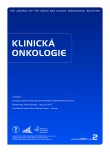Monitoring the Effectiveness of Surgical Treatment of Malignant Pleural Effusions
Authors:
P. Habal 1; J. Manďák 1; J. Šimek 1; M. Štětina 1; K. Jankovičová 2; K. Kondělková 2; J. Krejsek 2
Authors‘ workplace:
Kardiochirurgická klinika, Univerzita Karlova v Praze
1; Ústav klinické imunologie a alergologie LF a FN v Hradci Králové
2
Published in:
Klin Onkol 2010; 23(2): 99-103
Category:
Original Articles
Overview
Backgrounds:
Recurrent pleural effusion occured in 10% of cancer patients. Repeated thoracocentesis or drainage may be complicated by pneumothorax, haemothorax or pleural cavity infection. Thoracoscopic talc poudrage is one of the most effective pleurodesis technique in patients with malignant pleural effusions. The effectiveness of such pleurodesis is reaching the 70 to 90%. This surgical approach also allows to take a biopsy for histological verification of the process. An effort to predict the success rate of chemical pleurodesis on the basis of the body’s general inflammatory reaction rate, which is determined by the dynamics of values of humoral and cellular inflammatory parameters in both serum and in pleural effusion. Patients: In the period 6/2008–12/2009 we applied biotalcum to 14 patients with malignant pleural effusions. The group of patients consisted of 10 male patients and 4 female patients of average age 71 years. Indication to include patients in the group was a second or further thoracic puncture, shortening of the interval between interventions, estimated time of survival > 3 months and the possibility of operation under selective pulmonary ventilation. Method: We performed the collection of pleural effusion and blood serum at 12-hour intervals. The first collection was performed preoperatively before biotalcum application, and then during the time of losses from thoracic drainage bigger than 150 ml in 24 hours. The duration of thoracic drainage was 4 days ± 1 day. The success of the treatment was observed by ultrasound scan before drainage removal; during the first three months always at intervals of 1 month and then after 3 and 6 months, depending on the progression of a disease. Results: No reccurence occured when the P-CRP (pleural) and S-CRP (serum) ratio exceeded 60 % during the first 48 hours after pleurodesis. On the other hand, when the ratio fall bellow 30-35 %, the effusion relapsed frequently. Conclusion: The P-CRP/S-CRP ratio as a promising marker of talc pleurodesis effectiveness and monitoring both P-CRP and S-CRP levels is inexpensive and acceptable method for clinical practice. The pleural effusion caused by malignant mesothelioma appeares to be resistant to talc pleurodesis.
Key words:
malignant pleural effusion – thoracoscopy – biotalcum – CRP
Sources
1. Volanakis JE. Human C‑ reactive protein: expression, structure, and function. Mol Imunol 2001; 38: 189– 197.
2. Colt HG. Thoracoscopic management of malignant pleural effusions. Clinics in Chest Med 1995; 16(3): 505– 518.
3. Marel M, Zrůstová M, Šťastný B. The incidence of pleural effusion in a well‑defined region: epidemiologic study in central Bohemia. Chest 1993; 104: 1486– 1489.
4. Marel M, Fila L. Diferenciální diagnostika a léčba maligních pleurálních výpotků. Klin Onkol 2001; 1(zvl. č.): 16– 19.
5. Assi Z, Caruso JL, Herndon J et al. Cytologically proved malignant pleural effusions: distribution of transudates and exudates. Chest 1998; 113: 1302– 1304.
6. Chernow B, Sahn SA. Carcinomatous involvement of the pleura: An analysis of 96 patients. Am J Med 1977; 63: 695– 702.
7. Ruckdeschel JC. Management of malignant pleural effusion. Semin Oncol 1995; 22: 58– 62.
8. Vargas FS, Teixeira LR. Pleural malignancies. Curr Opin Pulm Med 1996; 2: 335– 340.
9. Ryan CJ, Rodgers RF, Unni KK. The outcome of patients with pleural effusions of indeterminate cause at thoracotomy. Mayo Clin Proc 1981; 56: 145– 149.
Labels
Paediatric clinical oncology Surgery Clinical oncologyArticle was published in
Clinical Oncology

2010 Issue 2
- Metamizole vs. Tramadol in Postoperative Analgesia
- Metamizole at a Glance and in Practice – Effective Non-Opioid Analgesic for All Ages
- The Importance of Hydration in Wound Healing
- Obstacle Called Vasospasm: Which Solution Is Most Effective in Microsurgery and How to Pharmacologically Assist It?
- Possibilities of Using Metamizole in the Treatment of Acute Primary Headaches
Most read in this issue
- Low‑ Dose Radiotherapy in the Treatment of Plantar Fasciitis
- Prostate Bed Radiotherapy – When and What?
- Sentinel Lymph Node Identification Using Hysteroscopy in Patients with Endometrial Cancer
- Our Experience with Analysis of the PTEN Gene in Patients Suspected of Having Cowden Syndrome
